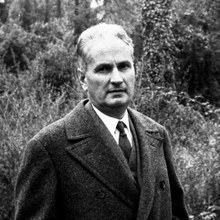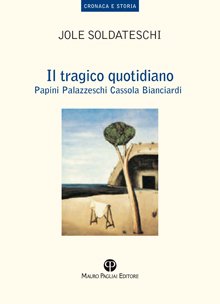Ricerca Veloce
Ricerca Avanzata

Carlo Cassola
Carlo Cassola nasce a Roma nel 1917 e trascorre la maggior parte della sua vita in Toscana a Volterra, luogo di origine della madre. Inizia l’attività letteraria negli anni ’30: tra il 1937 e il 1940 compone una serie di brevi racconti poi raccolti in un volume dal titolo La visita. Vive alcuni anni a Grosseto, dove svolge la professione di insegnante di filosofia, pubblicando molti articoli su «Il Mondo», «Il Nuovo Corriere - La Gazzetta» e «Il Contemporaneo» nei quali denuncia le condizioni di vita e di lavoro dei minatori maremmani. Partecipa alla resistenza, quindi pubblica Baba (1946), Fausto e Anna (1952), e I vecchi compagni (1953), tutti di argomento partigiano e ambientati in quel particolare paesaggio letterario che per Cassola era il triangolo Volterra – Marina di Cecina – Grosseto.
Con il racconto lungo Il taglio del bosco, scritto tra il ’48 e il ’49 ma pubblicato nel 1954 la sua prosa si allontana dalle tematiche storiche per assumere un tono più intimistico. Cassola mette a punto la sua poetica del “realismo subliminale”, e in questa sua ricerca riconosce come suo unico maestro il Joyce di Gente di Dublino. Nel 1954 collabora con Luciano Bianciardi alla redazione di un’inchiesta da cui verrà tratto nel 1956 il libro di denuncia I minatori della Maremma.
Con Il soldato nel 1958 Cassola vince il Premio Salento. Nel 1960 viene pubblicato La ragazza di Bube, che verrà insignito del Premio Strega.
Il lavoro di Cassola si conserva fedele alla propria poetica chiusa, minimale e volutamente astorica anche nella produzione seguente che, tra romanzi e racconti, si mantenne regolare e costante: Un cuore arido (1961), Il cacciatore (1964), Tempi memorabili (1966), Storia di Ada (1967), Ferrovia locale (1968), Una relazione (1969). La sua visione del mondo e i suoi motivi ispiratori si vanno poi modificando negli anni ’70, come testimonia il romanzo Paura e tristezza (1970), in cui lo scrittore si distacca dalla “commedia umana” per orientarsi verso una narrativa di impegno, ispirata ad argomenti di attualità, di politica, di problematica sociale. Le opere successive, L’uomo e il cane (1977) e Il superstite (1978), sono tappe di questa evoluzione.
Negli ultimi anni Cassola si dedica con passione all’attività antimilitarista ed ecologista, mantenendosi sempre autonomo dai gruppi politici ufficiali. Costretto all’immobilità da una grave malattia, lo scrittore si spegne nel 1987 a Montecarlo, in provincia di Lucca.
Carlo Cassola was born in Rome in 1917 and spends most of his life in Volterra (Tuscany), hometown of his mother. He starts his literary activities in the 30s: between 1937 and 1940 he writes a series of short stories later collected in the volume “La Visita”. He lives for some years in Gorsseto, where he works as philosophy teacher, publishing many articles on “Il Mondo”, “Il Nuovo Corriere-La Gazzetta” and “Il Contemporaneo” in which he denounces the live and working conditions of the minors and the area of Maremma. He takes part to the Resistenza, and consequently releases “Baba” (1946), “Fausto e Anna” (1952), and “I vecchi compagni” (1953), all of the novels are about partisans and are set in a unique literary landscape, located between Volterra, Marina di Cecina, and Grosseto.
With the log story “Il taglio del bosco,” written between ’48 and ’49, but published in 1954, he steps away from the historical themes and his poetics gains a more intimate tone. Cassola develops his own poetics of the “subliminal realism” and identifies as his mentor Joyce and his “Dubliners”. In 1954 he works with Luciano Bianciardi on an investigative report from which, in 1956, will be inspired the book “I minatory della Maremma”.
With “Il Soldato”, Cassola wins the award “Premio Salento” (1958). In 1960 “La ragazza di Bube” is published, and will later receive the award “Premio Strega”.
Cassola’s production remains faithful to his close, minimalist poetic, intentionally ahistorical, and regular and constant in the following years. Example of this period are:” Un cuore arido” (1961), “Il cacciatore “(1964), “Tempi memorabilia” (1966),”Storia di Ada” (1967), “Ferrovia locale” (1968), “Una relazione” (1969). His vision of the world and his sources for inspiration later changed in the 70s, as shown in the novel “Paura e Tristezza” (1970), in which the writer distances himself from the “human comedy” and is oriented towards a form of narrative involved in the social cause, inspired by political and social issues. His next works “L’uomo e il cane” (1977) e “Il superstite” (1978), are examples of this evolution.
In his last years, Cassola is committed toward antimilitaristic and ecologist activities, always remaining outside official political groups. Compelled to be immobile because of a serious disease, the writer dies in 1987 in Montecarlo, close to Lucca.
Vedi anche...
Il tragico quotidiano
- € 15,30
- € 18,00
